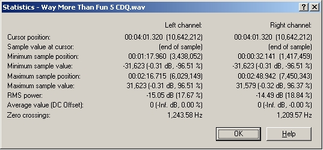G
Greg_L
Banned
I can't believe nobody's even questioning this. It makes zero sense.
I noticed it but it's best to just let these things stay terrible.
I can't believe nobody's even questioning this. It makes zero sense.
sorry, i edited it to include the mastering meter.
OK, didn't see that. Yeah, try right clicking or checking the manual to see if there's anything like what I'm talking about. It's not really "mastering settings". It's just something that might be adjustable on the master fader.
When referencing RMS levels it helps to specify the measurement tool. Some use a 0dB square wave and some use a 0dB sine wave. The ones using the sine wave will show a given file as "louder" (lower RMS number) by several dB than the ones using square wave.
I think bsg is going to have explain that one or link to something that demonstrates what he's talking about.It might also have nothing to do with what I'm saying. It could be this, too....which I never knew:


I'll check out the Wiki article later. But ok, that helps explain it. I actually used to have the TT DR meter years ago, but I stopped using it because it was always giving me much higher RMS levels than REAPER's meters, so I just decided to go with REAPER, especially since I knew my stuff wasn't averaging -9 or -8 RMS. It would be distorting to all hell if it was. So, I though the TT DR meter was just full of shit. Now I know that it probably wasn't full of shit, it was just giving the "other" reading.It's a discrepancy I've seen before, something I read about after I had been noticing it. A sine wave has less power that a square wave with the same peak, so there's less of a difference between that and any given song's level, and that gives a smaller number than when a square wave is the reference for 0dB RMS. It's consistent, things always seem to be one or the other level.
I think this explains it, first section "RMS levels": https://en.wikipedia.org/wiki/DBFS
That's interesting, and something I never really thought about. I guess I always assumed that the RMS readings were referenced to the same 0dbfs level as the peaks, but I guess in most, 0db is the RMS level of a sine wave peaking at 0dbfs. I can say that Reaper (by default, if you haven't changed its settings) agrees with SoundForge.I think this explains it, first section "RMS levels": https://en.wikipedia.org/wiki/DBFS
None of your links in this thread are working for me. They all take me to a page that says "Limiter test", but it says there are no tracks on the page.
I had a bit of a crisis on this for a minute, but I'm feeling better now. Those of us with meters calibrated to the square wave standard (which read lower) are fine here because it basically is referenced to 0dfs. The other way is just screwey.That kind of confuses the issue of dynamic range, though, doesn't it? I mean, I would normally subtract RMS from peak to get DR, but if they're not referenced to the same level, you can't get a meaningful result...

Those of us with meters calibrated to the square wave standard (which read lower) are fine here because it basically is referenced to 0dfs. The other way is just screwey.
